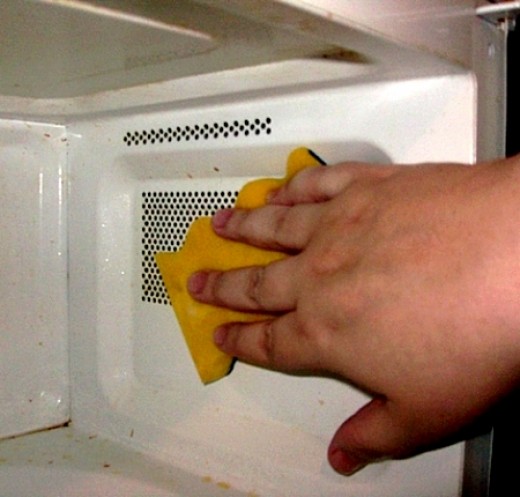Best Way to Clean Inside Microwave Ovens - Easy, Safe Remedies
The microwave oven is one appliance in the kitchen that is so easy to forget to clean. The door is only opened for microsecond to insert and remove the item being cooked. Since the door is usually left closed when the microwave oven is not being used, the splatters and spills can build up before you really notice them.
But dirt and grime can be health hazards anywhere in the food preparation area so it is important to regularly clean your microwave oven. Many people balk at doing this cleaning job, because they don't understand how to do it.
Many others are concerned about the safety issues of using too much hot soapy water and chemicals inside of oven. They are concerned about may happen with bleaches and other cleaning agents when exposed to microwaves. They are also worried about not scratching the inside wall surfaces There is also concern that the strong odors of various cleaners may taint the food.
Fortunately, the inside of a the microwave oven can be cleaned thoroughly and safely in about 10 minutes with an extra 5-10 minutes needs for badly stained ovens caked with food residues.
This article provides advice on the best cleaning methods, safety issues and the items needed to routinely clean your microwave oven so that it is sparkling clean and all odors are removed.


Using Steam and Vinegar
One of the simplest way to clean the inside of microwave is putting a bowl of water in the oven and heating it so that it forms steam, softening the grime on the sides of the oven. You can boost the cleaning power by adding a tablespoon of vinegar to a cup of warm water and 1-2 drops of detergent. Mix and add to a microwave safe bowl.
Heat the water and vinegar in the bowl for about four minutes on a high setting. Be careful not to let the pressure in the oven build-up so that it forces the door open. After heating for about four minutes, leave the oven shut for about fifteen minutes.
Then, thoroughly wipe the inside of the microwave with a damp sponge. You an add a little baking soda to one sponge, and then wipe over with another sponge soaking in vinegar.
This will create a fizzing reaction which will help move the toughest stains and marks. This treatment also helps to deodorizes.
Using Steam with Lemon Juice
You can apply a similar method by replacing the vinegar with lemon juice in the bowl used for creating steam. Rubbing stained areas with half or a quarter of a whole lemon also works well.
Using a Heated Wet Sponge of Cloth
If you are concerned about creating too much steam pressure with a bowl of water in the oven, you can use a wet cloth as well. Dampen a cleaning sponge or a large cloth with the lemon or vinegar solution. Heat the cloth or sponge in the microwave on high, for about 2 minutes. This will release a controlled amount of stream. Then simply use the hot cloth to wipe out the inside of the oven.
Using Baking Soda and Water
A good general purpose solution for cleaning the inside of microwave ovens is to dissolve about 4 tablespoons of baking soda in 1 quart (2 litres) of warm water. This can be used to wipe down the inside of the microwave oven. You can add extra baking soda to the sponge to create a paste. Rinse off with diluted vinegar, which will react with the baling soda and leave no residues.
Cleaning the Inside of the Door
The door is much easier to get at, and can be easily washed with hot soapy water, while it is open. Use a towel under the open door to catch the drips. To remove tough stain, put a little baking soda on a sponge or cloth and scrub the stains. Wipe over with diluted vinegar and rinse with clean water.
Cleaning the Outside of the Microwave
This can be done using general purpose spray cleaners similar to what you use on your white goods and kitchen utensils. Pay special attention to the vents. They can be cleaned with soapy water or vinegar, but wring out the cloths well to prevent liquid getting inside the machine.